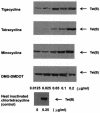Effects of efflux transporter genes on susceptibility of Escherichia coli to tigecycline (GAR-936)
- PMID: 15155219
- PMCID: PMC415592
- DOI: 10.1128/AAC.48.6.2179-2184.2004
Effects of efflux transporter genes on susceptibility of Escherichia coli to tigecycline (GAR-936)
Abstract
The activity of tigecycline, 9-(t-butylglycylamido)-minocycline, against Escherichia coli KAM3 (acrB) strains harboring plasmids encoding various tetracycline-specific efflux transporter genes, tet(B), tet(C), and tet(K), and multidrug transporter genes, acrAB, acrEF, and bcr, was examined. Tigecycline showed potent activity against all three Tet-expressing, tetracycline-resistant strains, with the MICs for the strains being equal to that for the host strain. In the Tet(B)-containing vesicle study, tigecycline did not significantly inhibit tetracycline efflux-coupled proton translocation and at 10 microM did not cause proton translocation. This suggests that tigecycline is not recognized by the Tet efflux transporter at a low concentration; therefore, it exhibits significant antibacterial activity. These properties can explain its potent activity against bacteria with a Tet efflux resistance determinant. Tigecycline induced the Tet(B) protein approximately four times more efficiently than tetracycline, as determined by Western blotting, indicating that it is at least recognized by a TetR repressor. The MICs for multidrug efflux proteins AcrAB and AcrEF were increased fourfold. Tigecycline inhibited active ethidium bromide efflux from intact E. coli cells overproducing AcrAB. Therefore, tigecycline is a possible substrate of AcrAB and its close homolog, AcrEF, which are resistance-modulation-division-type multicomponent efflux transporters.
Figures


Similar articles
-
Occurrence of tetracycline resistance genes among Escherichia coli isolates from the phase 3 clinical trials for tigecycline.Antimicrob Agents Chemother. 2007 Sep;51(9):3205-11. doi: 10.1128/AAC.00625-07. Epub 2007 Jul 9. Antimicrob Agents Chemother. 2007. PMID: 17620376 Free PMC article.
-
In vitro and in vivo antibacterial activities of a novel glycylcycline, the 9-t-butylglycylamido derivative of minocycline (GAR-936).Antimicrob Agents Chemother. 1999 Apr;43(4):738-44. doi: 10.1128/AAC.43.4.738. Antimicrob Agents Chemother. 1999. PMID: 10103174 Free PMC article.
-
Potential of Tetracycline Resistance Proteins To Evolve Tigecycline Resistance.Antimicrob Agents Chemother. 2015 Nov 23;60(2):789-96. doi: 10.1128/AAC.02465-15. Print 2016 Feb. Antimicrob Agents Chemother. 2015. PMID: 26596936 Free PMC article.
-
New developments in tetracycline antibiotics: glycylcyclines and tetracycline efflux pump inhibitors.Drug Resist Updat. 2002 Jul-Aug;5(3-4):119-25. doi: 10.1016/s1368-7646(02)00051-1. Drug Resist Updat. 2002. PMID: 12237079 Review.
-
The glycylcyclines: a comparative review with the tetracyclines.Drugs. 2004;64(1):63-88. doi: 10.2165/00003495-200464010-00005. Drugs. 2004. PMID: 14723559 Review.
Cited by
-
Comparison of Resistance Acquisition and Mechanisms in Erwinia amylovora against Agrochemicals Used for Fire Blight Control.Plant Pathol J. 2024 Oct;40(5):525-536. doi: 10.5423/PPJ.OA.07.2024.0106. Epub 2024 Oct 1. Plant Pathol J. 2024. PMID: 39397306 Free PMC article.
-
The TetR family of transcriptional repressors.Microbiol Mol Biol Rev. 2005 Jun;69(2):326-56. doi: 10.1128/MMBR.69.2.326-356.2005. Microbiol Mol Biol Rev. 2005. PMID: 15944459 Free PMC article. Review.
-
The challenge of efflux-mediated antibiotic resistance in Gram-negative bacteria.Clin Microbiol Rev. 2015 Apr;28(2):337-418. doi: 10.1128/CMR.00117-14. Clin Microbiol Rev. 2015. PMID: 25788514 Free PMC article. Review.
-
Tigecycline Efflux as a Mechanism for Nonsusceptibility in Acinetobacter baumannii.Antimicrob Agents Chemother. 2007 Jun;51(6):2065-9. doi: 10.1128/AAC.01198-06. Epub 2007 Apr 9. Antimicrob Agents Chemother. 2007. PMID: 17420217 Free PMC article.
-
Clinical and economic impact of common multidrug-resistant gram-negative bacilli.Antimicrob Agents Chemother. 2008 Mar;52(3):813-21. doi: 10.1128/AAC.01169-07. Epub 2007 Dec 10. Antimicrob Agents Chemother. 2008. PMID: 18070961 Free PMC article. Review. No abstract available.
References
-
- Abbanat, D., M. Macielag, and K. Bush. 2003. Novel antibacterial agents for the treatment of serious gram-positive infections. Expert Opin. Investig. Drugs 12:379-399. - PubMed
-
- Bryskier, A. 1999. Novelties in the field of anti-infectives in 1998. Clin. Infect. Dis. 29:632-658. - PubMed
-
- Chopra, I. 2001. Glycylcyclines: third-generation tetracycline antibiotics. Curr. Opin. Pharmacol. 1:464-469. - PubMed
-
- Chopra, I. 2002. New developments in tetracycline antibiotics: glycylcyclines and tetracycline efflux pump inhibitors. Drug Resist. Update 5:119-125. - PubMed
Publication types
MeSH terms
Substances
LinkOut - more resources
Full Text Sources
Other Literature Sources

